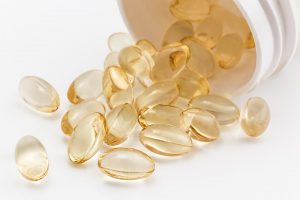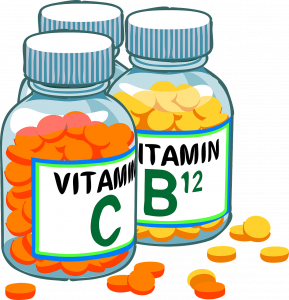10 Nutrients to Know – Vitamins
Vitamins
Shirley Tran; Alaura Vis; and Devin Godinez
What are Vitamins?
Vitamins are an organic molecule that is an essential micronutrient which an organism needs in small quantities for the proper functioning of its metabolism. In simpler terms, vitamins are a chemical substance needed for the human body to function properly. Many people take vitamins daily to help with a specific function. We will learn later in this chapter which vitamins can be taken daily. There are 13 different vitamins, such as “A, C, D, E, K, and the B vitamins (thiamine, riboflavin, niacin, pantothenic acid, biotin, B6, B12, and folate)” (U.S Department of Health and Human Services).

Vitamins are considered to be either water or fat-soluble. Fat-soluble vitamins can dissolve in fats and oils. The vitamins considered to be fat-soluble are A, D, E, and K. Water-soluble vitamins dissolve in water, vitamin C, and the complex elements of vitamin B are included in this category. All vitamins have their functions. For example, Vitamin A helps “maintain healthy teeth, bones, soft tissue, mucous membranes, and skin” (U.S. National Library of Medicine), while vitamin B12 helps with metabolism.
Test Your Knowledge
What are the pros and cons of vitamins?

Over half of Americans take some multivitamin each day. While there can be some benefits to taking vitamins, certain kinds can be risky for individuals, and getting too much of some vitamins can create dangerous symptoms. Vitamins may be needed for digesting food, condition of hair, nails, eyesight, heart, nervous system, etc.
Taking vitamins includes staying fit, healthy, supple, and strong because vitamins are essential nutrients that the body needs to perform certain chemical reactions and do its job properly. The most common use of vitamins includes vitamin D and folic acid. Folic acid vitamins are mainly used by women who are pregnant or who are trying to get pregnant. On the other hand, Vitamin D is taken by men and women who use it for its classification as a fat-soluble vitamin. Vitamin D also influences cell growth and immune function, which keeps inflammation and check and keeps your nervous system working correctly.
The cons of taking vitamins include toxicity symptoms, such as headaches, flush skin, or an upset stomach. Or they can get as bad as kidney stones, heart issues, and confusion. If you take an excessive amount of vitamins a day over many years, your bones are more likely to fracture, or they may also interfere with other medications.
Which vitamins can be taken daily, and which can not?

After researching, you may take any vitamin daily. However, It is possible to have too much of a vitamin intake and cause problems for the body. We will start with the vitamins you can take daily. Vitamin D, Magnesium, Calcium, Zinc, Folate, and Vitamin B-12 can all be taken daily (Healthline, 2020). These vitamins can be achieved with a specific food, such as egg yolk for Vitamin D, milk for Calcium, beans for Folate. Due to differences in taste buds, we may not obtain these vitamins from food. Therefore we can achieve through a multivitamin daily if needed. A random fun fact, you can obtain Vitamin D by sunbathing for 15 minutes (Healthline, 2020). All seven of the vitamins listed above are beneficial to our body functions. Zinc supports our immune system, and Magnesium can help with sleep problems. It is important to figure out which vitamins you lack from food intake and use vitamins for balance.
As mentioned above, it is easy to overdose on your vitamin intake (Nourish by WebMD, 2014). When you have a high intake of any vitamin, it can begin to disrupt your body, such as causing sleeping problems, numbness, and/or irritability. If one takes a daily multivitamin, usually they should not worry about overdosing. When these vitamins are taken separately is when one should pay more attention to their intake.
How do vitamins and supplements work together?

Taking vitamins and supplements together is not recommended. When taken together, they can reduce the absorption and may result in adverse interactions that can harm your health. The vitamin and supplement combinations you would want to avoid are calcium and magnesium, copper and zinc, fish oil and ginkgo Biloba, iron and green tea, calcium and vitamin D, niacin combinations and cholesterol, folate supplement and vitamin B 12, and vitamins K & E.
What would happen without vitamins?
Vitamin deficiency anemia can develop if your diet or your eating routine is lacking in certain vitamins. It happens because the red blood cells, which carry oxygen from the lungs throughout the body, are produced by the vitamins. Even though deficiencies in most vitamins are rare in the U.S, there are still some cases that Americans have concerns about vitamins. The symptoms people may experience when they do not get enough vitamins are related directly to each vitamin’s function.

For example, vitamin A deficiency can cause anemia and dry eyes. Vitamin C deficiency causes anemia and scurvy, which leads to symptoms of weakness, gum disease, and skin problems. Vitamin D deficiency can result in bone loss, cancer, increased risk of death from cardiovascular or muscle weakness. Vitamin B-12 deficiency can cause extreme tiredness, lack of energy, feeling faint, and headaches.
We can prevent those risks from vitamin deficiency by choosing a healthy diet or meal that includes various foods. For example, we can have some foods that rich in vitamin B-12, such as eggs, fortified food (such as cereals), milk, cheese, yogurt, and meat in the morning; and some foods that rich in vitamin C, such as broccoli, citrus fruits, strawberries, green peppers, and tomatoes for a snack, or we can use them as an add-on for lunch. Balancing the intake of vitamins will help us always stay healthy.
Test Your Knowledge


References
Cleveland Clinic. “Vitamin Deficiency Anemia.” Cleveland Clinic, Friday March 2018, https://my.clevelandclinic.org/health/diseases/17732-vitamin-deficiency-anemia.
U.S Department of Health and Human Services. “Healthy Eating.” Vitamins and Minerals, Monday, April 2019, https://www.nia.nih.gov/health/vitamins-and-minerals.
U.S. National Library of Medicine. “Vitamins.” Medline Plus, 8 October 2020, https://medlineplus.gov/ency/article/002399.htm.
Healthline. (2020, July Thursday). 7 Ingredients Your Multivitamin Should Have. https://www.healthline.com/health/food-nutrition/best-vitamins-to-take-daily#1.-Vitamin-D
Nourish by WebMD. (2014, April Wednesday). Getting Too Many Vitamins and Minerals. https://www.webmd.com/diet/guide/effects-of-taking-too-many-vitamins#2
Media Attributions
- orange-1995056_1920 © Image by S. Hermann & F. Richter is licensed under a Public Domain license
- fruit-2367029_1920 © Image by silviarita is licensed under a Public Domain license
- salad-1672505_1920 © Image by RitaE is licensed under a Public Domain license
- pill-3069032_1920 © Image by Steve Buissinne is licensed under a Public Domain license
- salad-2756467_1920 © Image by silviarita is licensed under a Public Domain license
- vitamins-26622_1280 © Image by Clker-Free-Vector-Images is licensed under a Public Domain license

